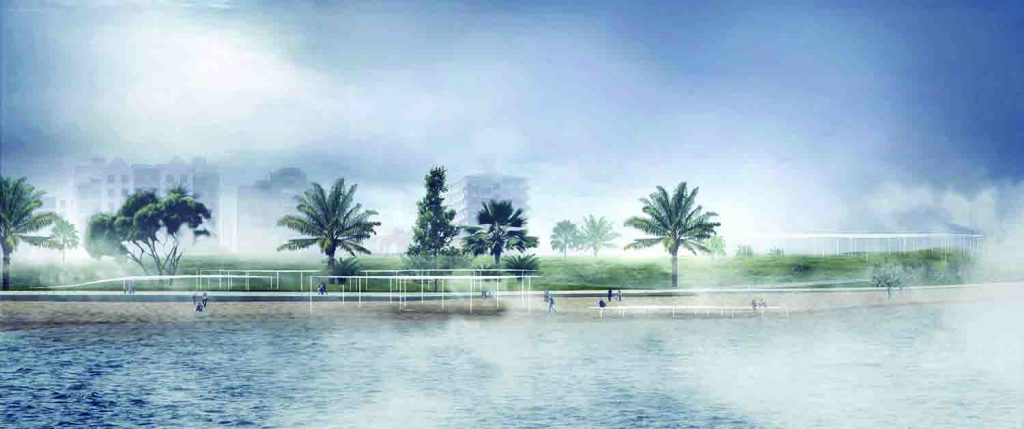
Artist Team: Yuxun Emmeily Zhang, Alexandra Siu, Liyang Zhang
Energy Technologies: transparent silicon solar mesh (Sphelar®), aerostatic flutter wind harvesting (Windbelt™)
Annual Capacity: 260 MWh
A submission to the 2018 Land Art Generator design competition for Melbourne
Head in the Clouds is a playful conceptual work of public art for St Kilda Triangle that rethinks the ubiquitous rooftop solar panel.
The artwork specifies two renewable energy technologies: A transparent silicon solar mesh (Sphelar®) woven into a tensile fabric canopy to capture light energy, which is sent as electricity to the City of Port Phillip’s grid, and aerostatic flutter wind harvesting (Windbelt™) technology attached to telescoping structural steel columns that hold the canopy aloft. The latter powers the up-and-down movement that creates the ephemeral billowing effect.
Due to their spherical shape which capture sunlight from every direction, the solar cells designed by Sphelar Power, a spinoff from Kyosemi, are capable of absorbing more energy than conventional flat solar cells.
Meanwhile, Windbelt technology invented by Shawn Frayn in 2004 consists of a flexible stretched ribbon installed between two points transverse to the wind direction. When the wind blows, the vibrating ribbon is capable of harvesting a small amount of kinetic energy due to aeroelastic flutter, an instability caused by the interaction between aerodynamic, inertial, and elastic forces.
On a windy day, the canopies will billow wildly, visually representing the wind’s inherent power. On quieter days, the canopy will remain static, though it will still absorb solar energy as long as the sun shines. Five canopies of varying size could potentially provide enough energy to power 52 Australian homes.

Artist Team: Yuxun Emmeily Zhang, Alexandra Siu, Liyang Zhang
Energy Technologies: transparent silicon solar mesh (Sphelar®), aerostatic flutter wind harvesting (Windbelt™)
Annual Capacity: 260 MWh
A submission to the 2018 Land Art Generator design competition for Melbourne
One of 25 shortlisted proposals submitted to the 2018 Land Art Generator design competition for Melbourne, Head in the Clouds was designed to complement the City’s heavily vetted plans for future growth around the competition site, according to the team’s spokesperson, Alexandra Siu. She says that she and partners Yuxun Emmeily Zhang and Liyang Zhang also sought to meet long-term sustainability objectives with a self-powered artwork that honors the “carnival-esque atmosphere” of nearby Luna Park and Palais Theatre.
“We wanted to do something new, too,” she adds. “We didn’t want to use whatever we know already, so we did a lot of digging.”
All master architecture students from the University of Waterloo in Canada, the team felt strongly that the form of their design needed to reflect its urban context. That’s how they eventually settled on a cloud-like structure.
“We thought that the clouds reflect the beach skyline. At the same time, it’s very playful, and reflects the whimsical character of the amusement park and Palais Theatre.”
Providing an inspirational and interactive amenity for visitors—especially as shade for sunbathers or shelter for other activities—Siu says the lightweight pavilions also preserve views to Port Philip Bay, an important component of the design brief that acknowledges the site’s importance to locals.
Elizabeth Monoian and Robert Ferry, the co-founders of the Land Art Generator Initiative, admire the team’s ability to conceive a Land Art Generator artwork that is equal parts delightful and functional.
“We love the way that the installation shifts in response to the weather, similar to the way that some flowers will open and close based on sunlight or the time of day. The artwork is dynamic and organic, as if it evolved naturally to live on the site with the mandate to generate clean energy and provide a beautiful place for people throughout the year.”

Artist Team: Yuxun Emmeily Zhang, Alexandra Siu, Liyang Zhang
Energy Technologies: transparent silicon solar mesh (Sphelar®), aerostatic flutter wind harvesting (Windbelt™)
Annual Capacity: 260 MWh
A submission to the 2018 Land Art Generator design competition for Melbourne
Siu says she and her team entered LAGI 2018 because they appreciated the challenge of creating land art that combines architecture, design, and renewable energy. They love the idea that energy generation can not only be beautiful, but also visible.
“Yeah we have windmills and solar panels, but they almost become things of the every day,” she says. “But when it’s land art, especially such a big piece, it becomes more apparent to people—and speaks to…how [renewable energy] can be used in other design objects and buildings. It could be more integrated.”

